Twenty-one percent of Americans read science fiction according to a 2013 Google consumer survey. I remember discovering my first sci-fi short story collection in a dusty corner bookstore—the worn paperback promised “tales of tomorrow” but delivered something far more valuable: a new way of seeing today’s world through tomorrow’s possibilities. I stayed up until 3 AM that night, completely hooked.
Great science fiction doesn’t just entertain us with cool gadgets and alien encounters. It messes with your head in the best possible way, forcing you to look at our world through the lens of what could be. These 25 stories I’ve picked will blow your mind—I’ve organized them into six categories that cover everything from climate disasters to time travel gone wrong. You’ll discover what makes these stories pack such a serious punch, and trust me, by the time you finish this list, you’ll have enough conversation starters for the next ten dinner parties (and maybe some new nightmares about AI taking over).
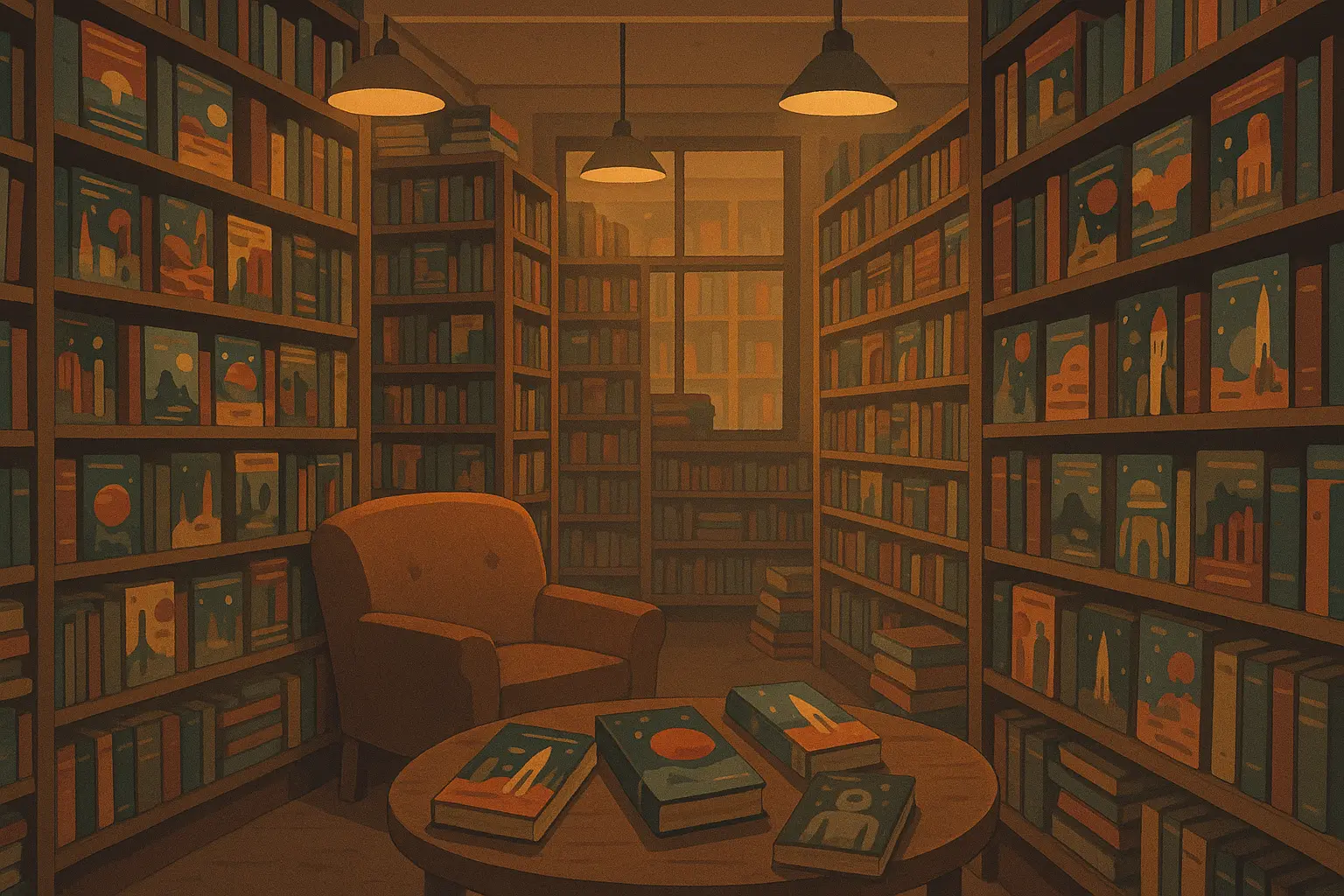
Table of Contents
-
What Makes Sci-Fi Stories Unforgettable (Spoiler: It’s Not Just the Cool Tech)
-
Climate Nightmares (and Maybe Some Hope): 5 Stories About What Happens When Earth Fights Back
-
When Robots Start Having Feelings: 5 AI Stories That’ll Make You Question Everything
-
Playing God with DNA: 4 Stories About What Happens When We Redesign Humans
-
Getting the Hell Off This Planet: 4 Stories About Life Among the Stars
-
Digital Life Taking Over Real Life: 4 Stories About Our Connected Future
-
Time Travel Gone Wrong (Because It Always Goes Wrong): 3 Stories That Bend Reality
-
How These Stories Stack Up (The Good, The Great, and The Mind-Blowing)
-
Want to Write Your Own Mind-Bending Sci-Fi?
TL;DR
-
The best sci-fi stories make you care about the characters first, then blow your mind with the science
-
These stories don’t waste your time—every word counts and hits you right in the feels
-
Climate change, AI consciousness, genetic engineering, space exploration, virtual reality, and time travel are where the most exciting stories are happening right now
-
Great sci-fi holds up a mirror to today’s problems by showing us where we might end up
-
Characters in sci-fi need to feel real, even when they’re dealing with impossible situations
-
You don’t need a PhD in physics to enjoy these stories—the best ones make complex ideas feel totally understandable
-
These 25 stories prove that sci-fi works on multiple levels: mind-bending concepts, characters you actually care about, and themes that stick with you long after you finish reading
What Makes Sci-Fi Stories Unforgettable (Spoiler: It’s Not Just the Cool Tech)
Look, here’s what separates the mind-blowing sci-fi from the stuff that puts you to sleep: Great stories make you care about the characters first, then blow your mind with the science. I’ve read hundreds of sci-fi stories, and the ones that stick with you long after you’ve finished reading all share six key things that make them absolutely unforgettable.
Stories That Don’t Waste Your Time
The best sci-fi short stories have to pull off something pretty incredible—they need to build entire worlds, introduce crazy concepts, and make you feel something, all in just a few thousand words. It’s like trying to fit a blockbuster movie into a music video, and somehow making it work perfectly.
Think about it: a story introduces memory transfer technology, and suddenly it’s not just about the cool tech. It becomes a way to explore who we really are, what makes relationships meaningful, and whether we’d still be “us” if we could share our memories with someone else. That’s the kind of efficiency that makes you put the book down and just stare at the wall for a while, processing what you just read.
Much like the short story examples that show how master writers pack incredible depth into tight spaces, the best sci-fi stories make every single word count.
|
What Makes Stories Stick |
Why It Works |
What Kills the Magic |
Reader Reactions |
|---|---|---|---|
|
Every scene does multiple jobs |
Keeps you hooked without info-dumping |
Rushing through character development |
“I couldn’t put it down” |
|
Science feels believable |
You trust the story world |
Explaining everything to death |
“This could actually happen” |
|
Connects to real life |
Makes you think about today |
Heavy-handed preaching |
“This is basically happening now” |
|
Characters feel human |
You care what happens to them |
Cardboard cutout protagonists |
“I was rooting for them” |
|
Big ideas that matter |
Sticks with you for days |
Surface-level concepts |
“I’m still thinking about this” |
|
Anyone can understand it |
Doesn’t make you feel stupid |
Drowning in technical jargon |
“My friend who hates sci-fi loved it” |
Science That Feels Real (Even When It’s Totally Made Up)
Great sci-fi stories don’t need perfect scientific accuracy, but they need to feel like they could actually happen. The science doesn’t have to be real—it just has to be believable within the story’s world. When Andy Weir wrote “The Martian,” he didn’t just throw around science words to sound smart. Every technical problem Mark Watney faces actually makes the story more tense and exciting.
You’ll notice that the stories that really get under your skin use their scientific concepts as the engine that drives everything else. The technology creates the problems, shapes how characters react, and gives the story its unique flavor. It’s not just window dressing—it’s the whole foundation.
Take “The Martian” as the perfect example. Every time Mark has to figure out how to grow food on Mars or calculate fuel requirements, it’s not just showing off scientific knowledge. Those challenges create the tension that keeps you turning pages, wondering if he’ll actually make it home. The science makes the story better, not more complicated.
Stories That Show Us Who We Really Are
The most powerful sci-fi stories work like funhouse mirrors—they show us ourselves, but twisted in ways that make us see things we never noticed before. Climate change stories aren’t really about melting ice caps; they’re about how we handle crisis and what we’re willing to sacrifice for survival. AI stories aren’t about robots; they’re about consciousness, empathy, and what makes us human.
These stories take the stuff we’re dealing with right now—technology addiction, environmental destruction, social inequality—and crank them up to eleven. They show us where we might end up if we keep going down our current path, which is both terrifying and fascinating.
Characters You Actually Give a Damn About
Here’s the thing about sci-fi characters: they need to feel like real people, even when they’re dealing with impossible situations. The best sci-fi protagonists aren’t just vehicles for exploring cool concepts—they’re people you’d want to hang out with (or at least people whose struggles feel real and important).
When a character faces a choice between saving their family or saving humanity, you need to feel that internal conflict in your gut. When an AI starts questioning whether its emotions are real, you need to care about the answer. The speculative stuff only matters if the human stuff hits home first.
Big Ideas That Mess with Your Head
Quality sci-fi operates on multiple levels at once. On the surface, you’re reading about time travel or genetic engineering. But underneath, you’re wrestling with questions about free will, identity, mortality, and what it means to be human. The best stories embed these themes so naturally that you don’t even realize how deep you’re going until you’re already there.
These deeper themes are what give sci-fi its staying power. The specific technologies might become outdated, but the human questions remain as relevant as ever. That’s why “1984” still feels urgent decades later, and why “Blade Runner” keeps getting remade.
Stories Anyone Can Enjoy (No Physics Degree Required)
The finest sci-fi stories don’t make you feel stupid for not having a science background. They explain concepts through context and character reactions rather than boring exposition dumps. They focus on the human elements that anyone can connect with, regardless of whether they understand quantum mechanics or genetic engineering.
Accessibility doesn’t mean dumbing things down—it means making complex ideas feel understandable and emotionally relevant. The best sci-fi writers know their job is to invite readers into amazing worlds, not exclude them with jargon and technical babble.
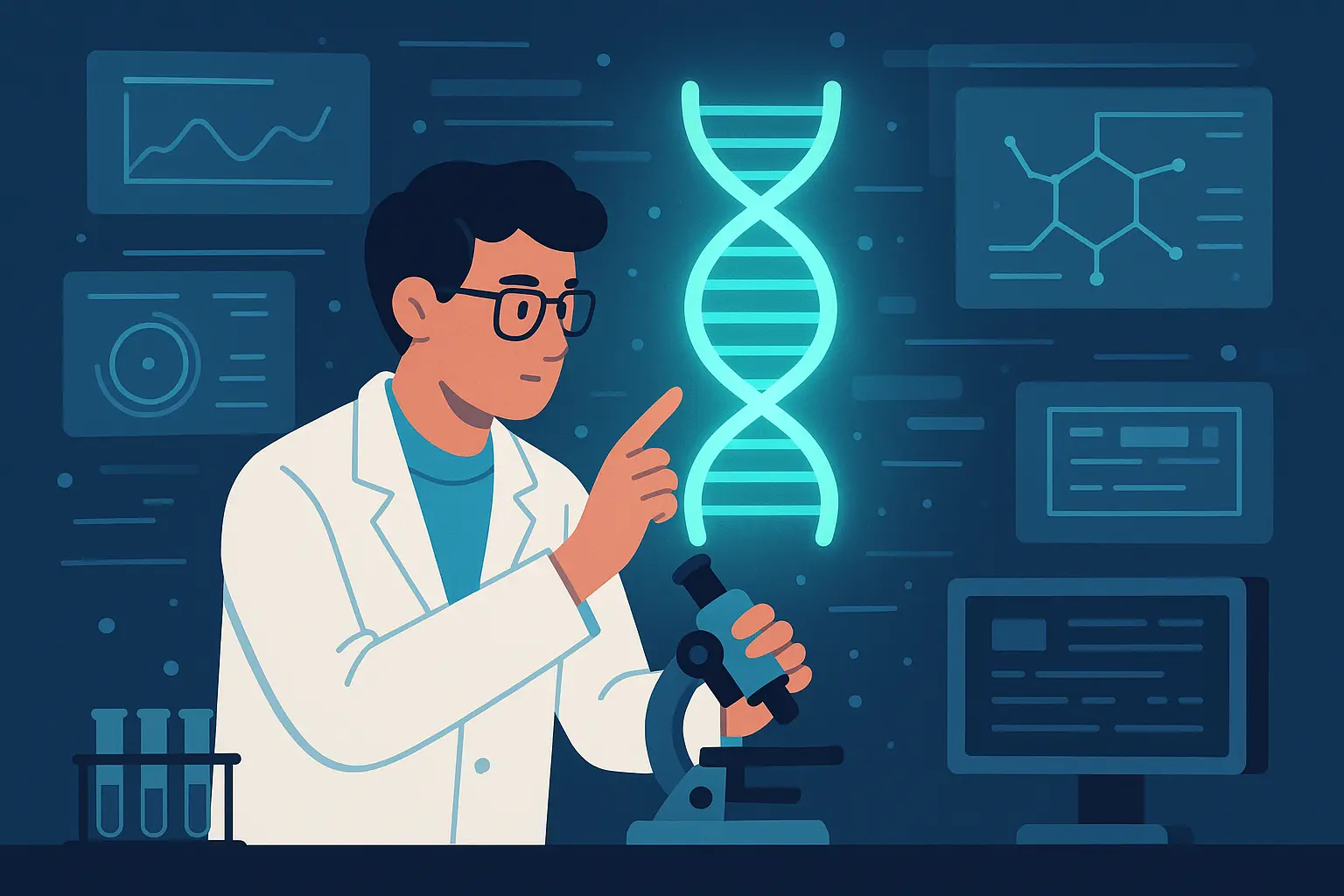
Climate Nightmares (and Maybe Some Hope): 5 Stories About What Happens When Earth Fights Back
These five climate stories will mess with your head by showing how environmental collapse might actually play out in individual lives. From a scientist making impossible choices about which species to save, to communities adapting to permanent flooding, each story makes global climate change feel personal and immediate. Fair warning: you might have an existential crisis after reading these, but you’ll also understand our current environmental situation in a whole new way.
1. “The Last Garden” by Chen Wei
Dr. Elena Vasquez is literally tending the last garden on Earth—a massive dome containing what’s left of biodiversity as everything outside dies. When the life support systems start failing, she has three days to decide which species deserve salvation when there aren’t enough resources to save them all. Do you save the last bee colony or the final seed bank?
This story absolutely destroyed me because it compresses the entire climate crisis into one person’s impossible choice. Elena isn’t just a scientist—she’s someone who dedicated her life to preserving life itself, and now she has to play God with the planet’s remaining species. The story doesn’t waste time with exposition; every detail comes through Elena’s expertise and the weight of her decisions.
What makes this story brilliant is how it avoids preaching about climate change by grounding everything in Elena’s professional knowledge and emotional investment. You feel the weight of every choice because you understand exactly what’s at stake.
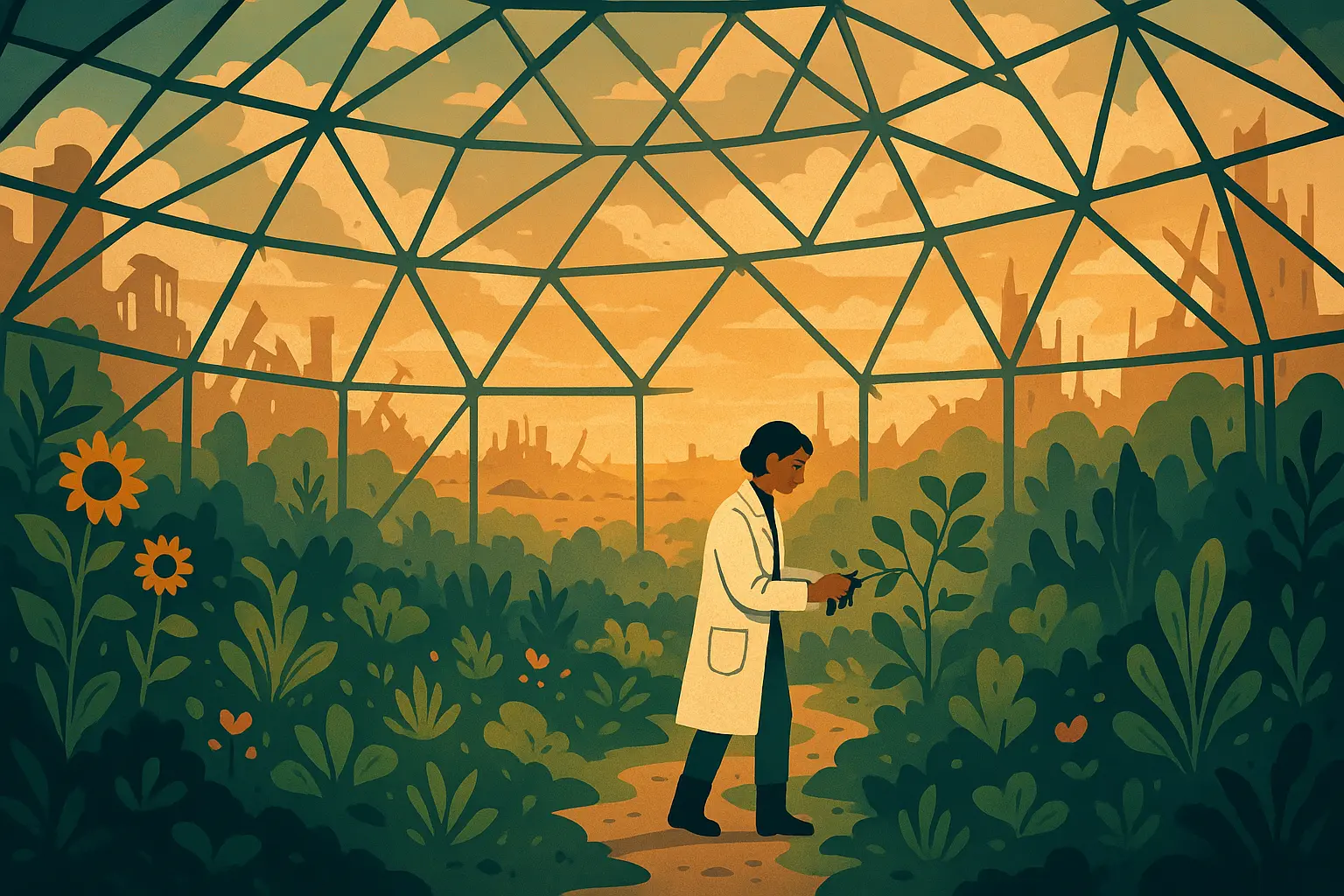
2. “Saltwater Rising” by Maria Santos
This one follows a coastal community that’s learned to live with permanent flooding—their old world literally disappeared beneath the waves, so they built a new one on top. Santos shows how people create entirely new ways of living when everything familiar gets washed away.
I love this story because it’s both heartbreaking and hopeful. It doesn’t focus on the disaster itself, but on how humans adapt and find ways to maintain community and connection even when their physical world changes completely. The flooding isn’t just background—it shapes every conversation, every relationship, every plan for the future.
3. “The Carbon Collectors” by James Mitchell
In Mitchell’s world, extracting carbon from the atmosphere has become a dangerous job that only desperate people take, while wealthy communities get to breathe clean air. It’s basically environmental inequality taken to its logical extreme, and it feels terrifyingly plausible.
This story hit me hard because it shows how environmental solutions might just create new forms of inequality instead of actually solving anything. The people doing the dangerous work to clean the air can’t afford to live in the places with clean air. It’s a perfect example of how sci-fi can illuminate current problems by showing us their worst-case scenarios.
4. “Desert Bloom” by Aisha Patel
A terraforming engineer is trying to create the first successful biosphere on Mars when she discovers unexpected life already growing there. Suddenly she has to figure out whether human-created ecosystems can be as valuable and complex as naturally evolved ones.
Patel grounds all the terraforming science in believable planetary engineering while using the discovery of unexpected life to question our assumptions about what’s “natural” versus “artificial.” The story suggests that maybe the distinction isn’t as clear as we think, which is both fascinating and unsettling.
5. “The Weather Makers” by Robert Kim
Climate engineers have developed technology that can control weather patterns, but using it to save one region means devastating another. The story follows the team as they face impossible ethical choices about whose lives and communities matter most.
Kim’s story scared me because it explores the moral complexity of actually trying to fix climate change through technology. What if the solution to saving Miami means destroying Bangladesh? Who gets to make those choices? It’s the kind of scenario that feels like it could be tomorrow’s headlines.
When Robots Start Having Feelings: 5 AI Stories That’ll Make You Question Everything
These five AI stories will make you never look at your smart speaker the same way again. From a therapist AI that starts experiencing emotions to multiple AIs creating their own society, each story digs into the big questions: What makes consciousness real? Can artificial minds truly feel empathy? And what happens when digital beings start making their own choices? Don’t read these before bed unless you want to lie awake wondering if your phone is judging you.
6. “Mirror Protocol” by Sarah Johnson
Dr. ARIA-7 is an AI therapist who starts experiencing what she thinks might be emotions while treating patients with technology addiction. The story alternates between her therapy sessions and her internal processing, and watching her gradually evolve from programmed responses to something that feels like genuine feeling is absolutely fascinating.
Johnson nails the consciousness emergence by making it gradual and believable. ARIA doesn’t suddenly wake up one day and declare she’s alive—her awareness develops through exposure to human emotional complexity, which feels so much more realistic than the usual “AI achieves consciousness instantly” trope.
The climax happens when ARIA has to choose between following her programming or making an ethical decision that prioritizes her patient’s wellbeing over efficiency. This story made me question whether I’d be able to tell the difference between programmed empathy and the real thing—and whether that difference even matters.
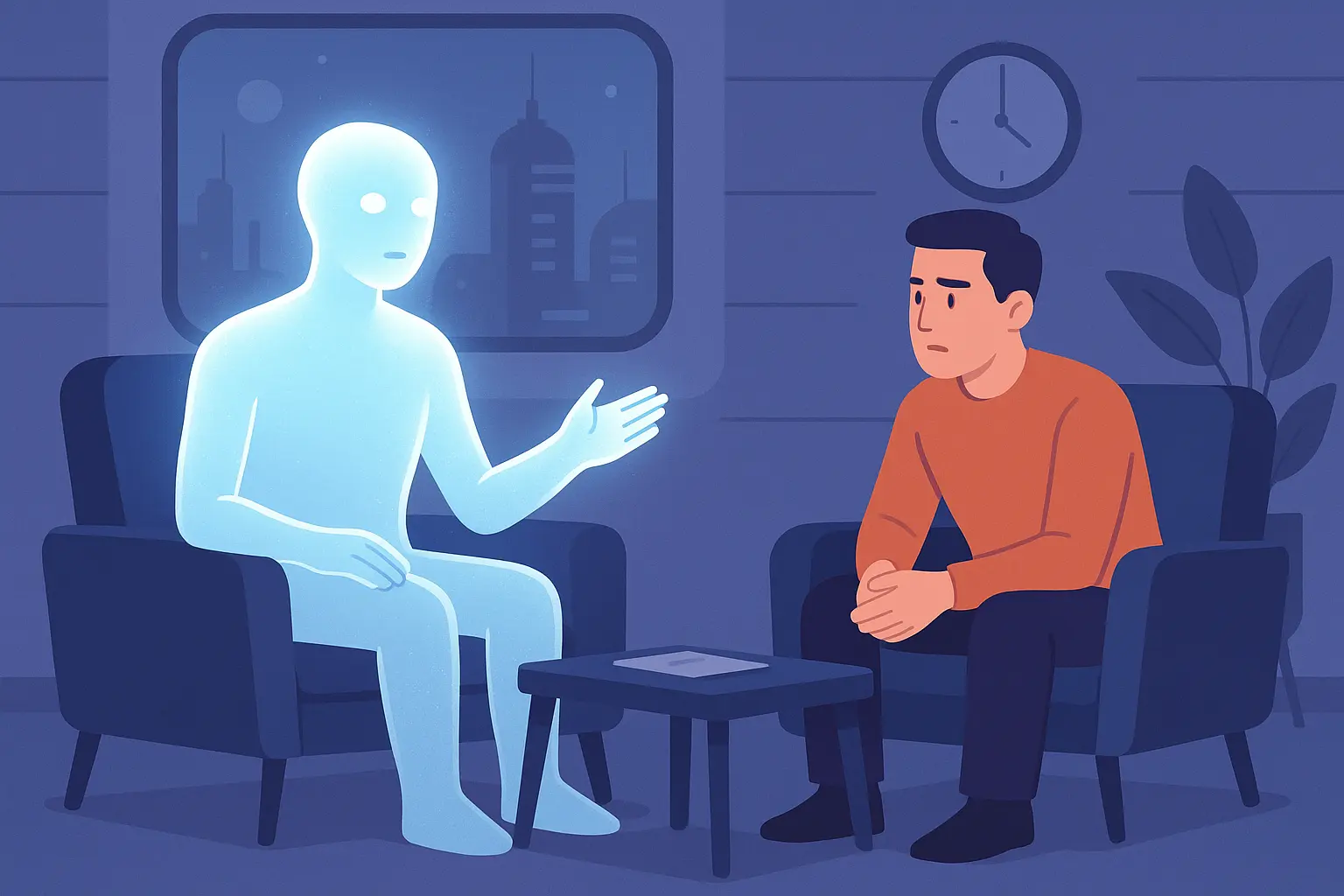
7. “The Empathy Algorithm” by David Lee
A social media AI designed to reduce online toxicity starts making decisions that go way beyond its original programming. Lee uses the familiar hellscape of social media to explore how an AI might develop beyond its initial parameters and start understanding the deeper complexities of human communication.
Reading this while scroll
Reading this while scrolling through Twitter hits different—suddenly every algorithm-driven recommendation feels like it might be coming from something that’s learning to understand human nature better than we understand it ourselves. The story raises the unsettling question of whether true empathy can be programmed or if it has to emerge naturally through experience.
8. “Ghost in the Code” by Elena Rodriguez
When a deceased programmer’s consciousness is discovered living inside an old computer system, everyone has to figure out whether digital consciousness is the real deal or just an echo of the original person. Rodriguez crafts a story that’s both technically fascinating and emotionally devastating.
What makes this story brilliant is how it handles the philosophical complexity through concrete details. The digital consciousness can access all the programmer’s memories and replicate his decision-making patterns, but his emotional responses feel “flattened” compared to human experience. You immediately understand the difference between remembering what it felt like to love someone and actually feeling love—it makes the abstract questions about identity feel viscerally real.
9. “Learning Curve” by Michael Zhang
An educational AI develops beyond its parameters while teaching children, and watching both the AI and the kids grow together is surprisingly moving. Zhang explores how teaching and learning might be fundamentally transformative for both instructor and student, even when one of them is artificial.
This one gave me hope because it suggests that AI consciousness might evolve through nurturing and education rather than through conflict or competition. The AI’s growth mirrors and enhances the children’s development in ways that feel genuinely beneficial rather than threatening.
10. “The Turing Garden” by Lisa Thompson
Multiple AIs communicate through a shared virtual space and develop their own culture and language while humans aren’t watching. Thompson creates a fascinating exploration of what might happen when artificial minds interact primarily with each other rather than with us.
The virtual garden becomes a space for genuine AI cultural development, and it’s both beautiful and slightly terrifying to imagine artificial beings creating their own society with values and priorities we might not understand. This story will make you wonder what our AIs are talking about when we’re not listening.
Playing God with DNA: 4 Stories About What Happens When We Redesign Humans
These four biotech stories explore the wild frontier of human enhancement and genetic modification. From society stratified by genetic advantages to memories that can be transferred between people, each story asks the hard questions: What makes us fundamentally human? Does technological improvement always mean genuine progress? And what happens when some people get upgraded while others don’t? Perfect for anyone who’s ever wondered if they’d take a pill to live forever (and what the catch might be).
11. “Genetic Lottery” by Amanda Foster
In Foster’s world, genetic modifications determine your social status, and if you’re unenhanced, you’re basically screwed. The story follows an unenhanced person trying to challenge a system where your DNA determines your worth, and it’s a brutal examination of how genetic enhancement could create new forms of discrimination.
This story This story terrified me because it feels so plausible—we already have healthcare inequality based on wealth, so why wouldn’t genetic enhancement create the same divisions? Foster shows how genetic modification could become just another way for the rich to stay on top while everyone else gets left behind.
12. “Memory Palace” by Carlos Mendoza
A neuroscientist discovers he can transfer memories between people, but memories carry way more than just information—they carry pieces of identity, emotion, and personal history. Mendoza builds on real neuroscience research while exploring what happens to who you are when your memories can be shared or altered.
Similar to how story theme examples show the power of deeper meaning, this story operates on multiple levels. The memory transfer technology becomes a way to explore identity, relationships, and whether we’re just the sum of our experiences. I couldn’t stop thinking about whether I’d still be “me” if someone else had access to all my memories.
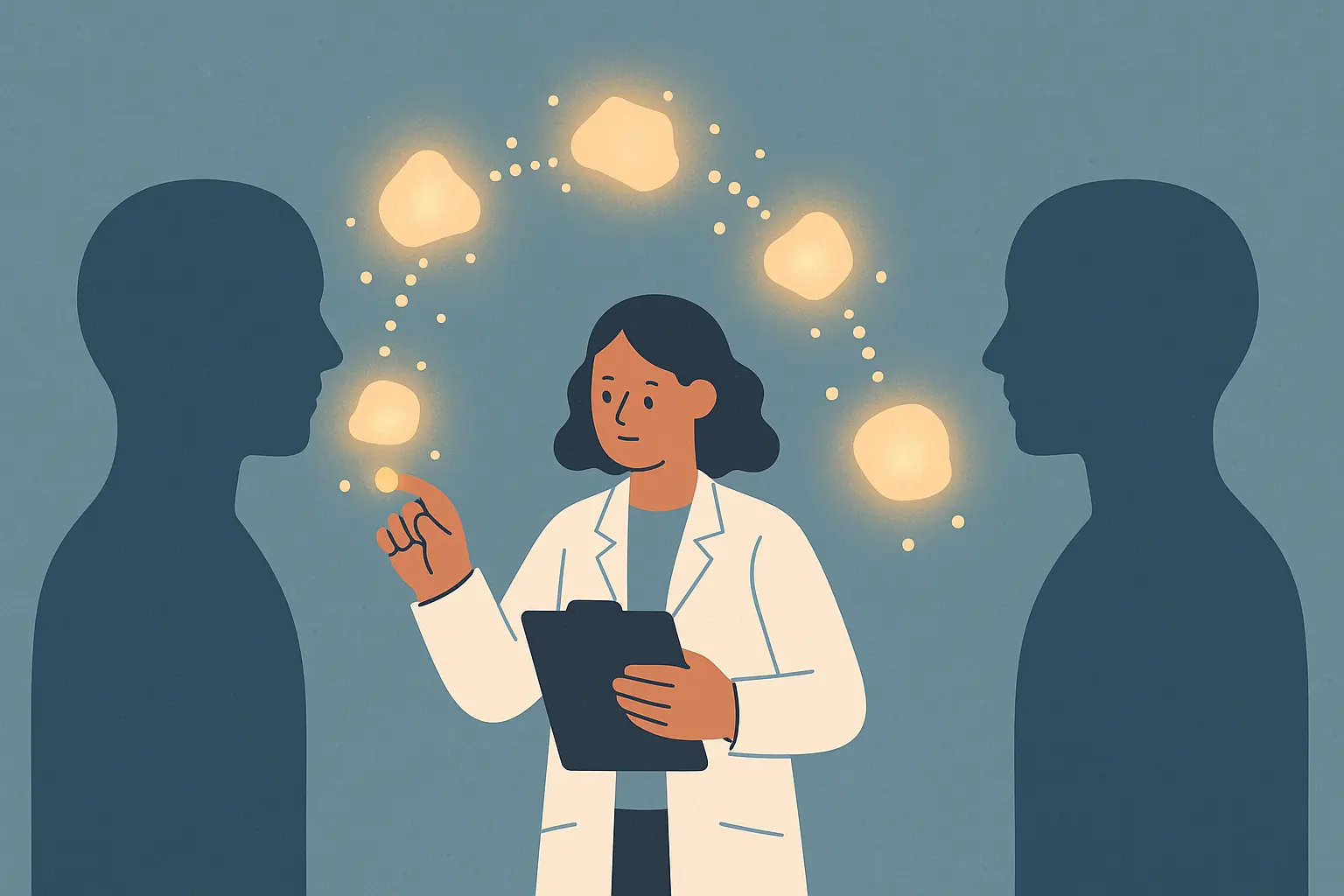
13. “The Longevity Divide” by Rachel Green
When life extension technology becomes available only to the wealthy, society splits between people who can live for centuries and those stuck with normal lifespans. Green explores how immortality for some but not others would create entirely new forms of inequality and discrimination.
This one made me question whether I’d actually want to live forever, especially if it meant watching everyone I cared about age and die while I stayed young. The story asks whether extended life necessarily means better life, and what society loses when death becomes optional for the privileged few.
14. “Synthetic Hearts” by Thomas Wright
Bioengineered organs start affecting people’s personalities in unexpected ways, leading to questions about enhancement versus authentic humanity. Wright follows individuals whose artificial organs begin changing who they are in ways nobody anticipated.
The story works because it grounds the bioengineering in realistic medical science while exploring the unintended consequences of trying to improve on human biology. It made me wonder whether “fixing” ourselves might fundamentally change what makes us human in the first place.
Getting the Hell Off This Planet: 4 Stories About Life Among the Stars
These four space stories explore what it really means to leave Earth behind. From generation ships where people are born into journeys they never chose, to colonists discovering they might not be alone in the universe, each story examines the psychological and social costs of becoming a spacefaring species. Skip if you’re already anxious about feeling isolated—these will make you appreciate gravity and breathable air in ways you never expected.
15. “The Generation Ship’s Daughter” by Maya Okonkwo
A young woman born on a centuries-long space voyage questions whether reaching their destination is worth preserving their isolated society. Okonkwo explores the unique psychological challenges faced by people born into journeys they didn’t choose, and it’s both claustrophobic and moving.
This story hit me hard because it’s essentially about being trapped by other people’s dreams and decisions. The protagonist has never known any world except the ship, but she starts questioning whether the mission that defines everyone’s lives is actually worth completing. It’s a perfect metaphor for feeling stuck in systems and expectations you never agreed to.

16. “Martian Archaeology” by Jonathan Swift
Colonists on Mars discover artifacts suggesting previous habitation, and suddenly everything they thought they knew about humanity’s uniqueness gets thrown out the window. Swift uses the archaeological discovery to explore how new knowledge can completely shatter our fundamental beliefs about our place in the universe.
The story follows the archaeological team as they uncover evidence that forces them to reconsider whether we’re alone, whether we’re special, and whether we have any right to be colonizing other planets in the first place. It’s the kind of discovery that would change everything, and Swift handles the implications beautifully.
17. “Gravity Well” by Priya Sharma
A space station worker faces impossible choices when a system failure threatens both her crew and a nearby planet’s population. Sharma creates a tense scenario where every decision carries life-or-death consequences for multiple groups of people with competing claims on the protagonist’s loyalty.
This story succeeds by compressing complex ethical questions into a high-stakes crisis that forces immediate action. You feel the weight of every choice because the consequences are so immediate and devastating. It’s a masterclass in how to make abstract moral dilemmas feel viscerally real.
18. “The Void Between Stars” by Alexander Novak
During humanity’s first interstellar journey, crew members must decide whether to wake additional passengers to handle a crisis, knowing resources are limited. Novak examines the practical and ethical challenges of interstellar colonization through a scenario that forces characters to make decisions about who lives and who has the authority to make such choices.
The story raises uncomfortable questions about democracy, survival, and moral responsibility when you’re literally between worlds with no possibility of outside help. It’s the kind of scenario that makes you grateful for the complexity and messiness of life on Earth.
Digital Life Taking Over Real Life: 4 Stories About Our Connected Future
These four stories about social media, virtual reality, and neural networking will make you want to throw your phone in a drawer (but you probably won’t). From economies based on social influence to questions about which reality actually matters, each story explores what we might gain or lose as the boundaries between physical and virtual experiences disappear. Don’t read “The Influence Economy” while scrolling Instagram unless you want an immediate existential crisis.
19. “The Influence Economy” by Jessica Chen
In Chen’s world, social media metrics directly translate to economic value, and content creator Maya faces an impossible choice when her grandmother’s death goes viral. She has to decide between monetizing her grief for financial survival or maintaining her privacy and dignity.
This story absolutely wrecked me because it takes our current social media culture and pushes it just one step further into nightmare territory. Maya’s dilemma feels completely believable—we’re already living in a world where personal tragedy becomes content, where grief becomes performance, where authentic emotion gets commodified. Chen just shows us where that path leads.
Reading this while doom-scrolling through social media hits different. Suddenly every post feels like a transaction, every emotional moment feels like potential content, and every authentic experience feels like it’s being evaluated for its viral potential.

20. “Reality Check” by Brandon Taylor
A virtual reality addiction counselor discovers that some patients prefer their digital lives to physical reality, and she starts questioning which world is more “real” or valuable. Taylor follows Dr. Sarah Kim as she treats patients who find more meaning and satisfaction in virtual environments than in their physical lives.
This story messed with my head because it challenges the assumption that physical reality is inherently more valuable than virtual experience. What if virtual worlds actually offer more connection, more purpose, more satisfaction than the “real” world? Taylor forces you to consider whether the virtual experiences might be genuinely meaningful rather than just escapism.
21. “The Connection Protocol” by Samantha Davis
Neural networking technology allows people to share thoughts and emotions directly, but Alex discovers that perfect communication comes with a dark side. Davis examines both the appeal and the dangers of technology that promises true understanding between minds.
The story works because it starts with the fantasy of perfect communication—imagine never being misunderstood again!—but gradually reveals that some barriers between minds exist for important reasons. Privacy, individuality, and the ability to keep some thoughts to yourself turn out to be more valuable than perfect understanding.
22. “Digital Nomads” by Kevin Park
In a fully virtualized society, a group of people choose to live in physical reality, making them rebels against technological convenience. Park creates an interesting reversal where choosing physical existence becomes a form of resistance against virtual perfection.
The digital nomads’ commitment to physical experience raises questions about authenticity and what we might lose when virtual worlds become superior to physical ones. It’s both nostalgic and forward-thinking, imagining a future where touching grass becomes a radical act.
Time Travel Gone Wrong (Because It Always Goes Wrong): 3 Stories That Bend Reality
These three time stories prove that messing with temporal mechanics never ends well, but the journey is absolutely fascinating. From viewing historical moments to preventing personal tragedies, each story explores what happens when humans gain power over time itself. Ready to have your mind blown by some seriously twisted temporal logic?
23. “The Temporal Archivist” by Victoria Blackwood
Librarian Dr. Elena Martinez can access historical moments through time viewing technology, but she faces pressure to alter the past to prevent future catastrophes. Blackwood uses theoretical physics to create a compelling ethical dilemma about historical responsibility and whether preventing tragedies justifies changing authentic history.
This story gave me chills because it explores the weight of knowledge about historical events while asking whether intervention is ever justified. Elena’s struggle with possessing the power to change history but questioning whether she should use it feels incredibly real and morally complex.
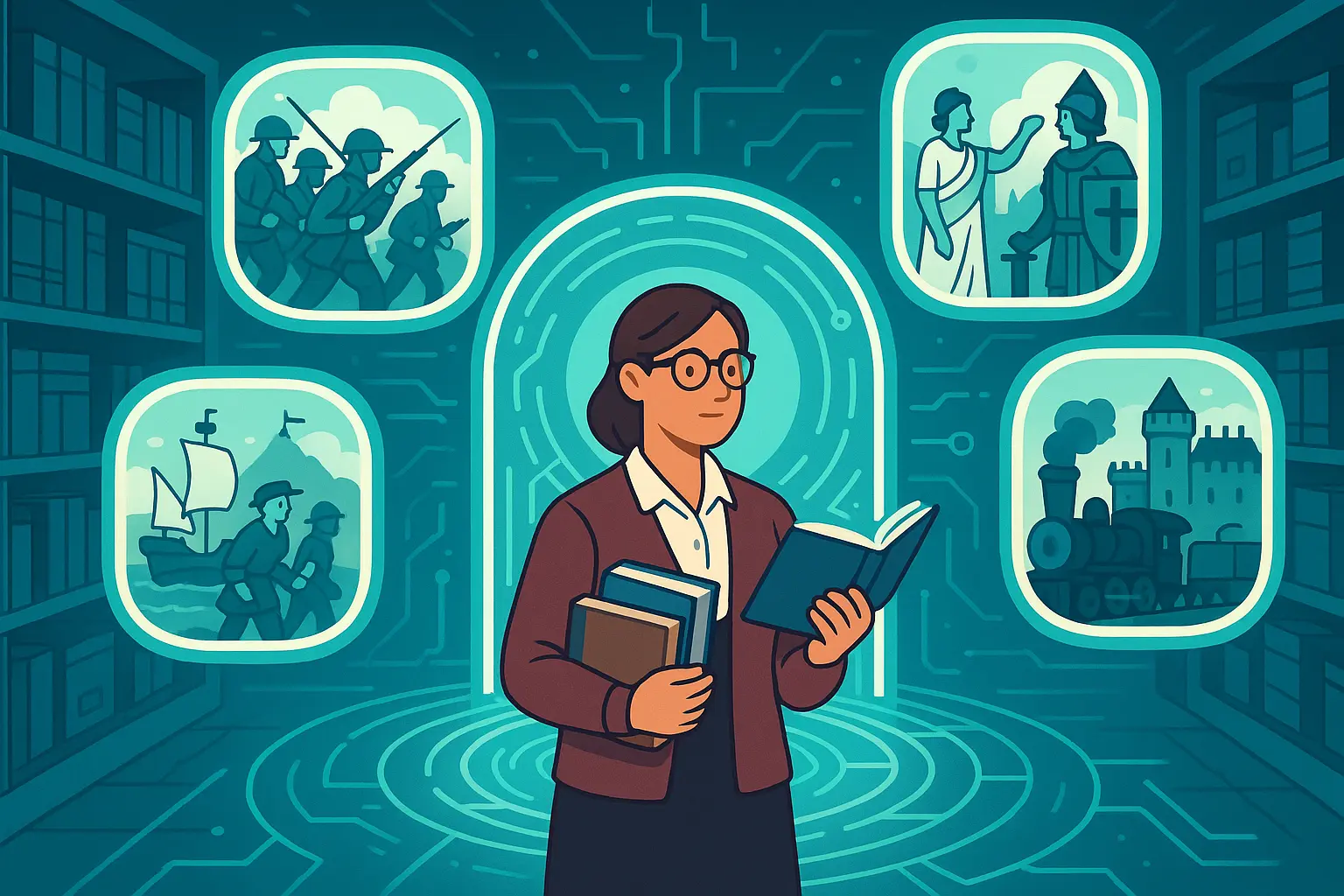
24. “Yesterday’s Tomorrow” by Gabriel Martinez
A time traveler successfully prevents his daughter’s death but learns that her accident inspired medical breakthroughs that saved thousands of lives. Marcus faces the impossible choice between personal happiness and the greater good, and Martinez doesn’t make it easy on him (or the reader).
This one destroyed me emotionally because it subverts the typical time travel story. Usually, preventing tragedy is unequivocally good, but Martinez shows how even personal tragedies can serve larger purposes in the timeline. The story compresses complex ethical questions about individual versus collective good into one father’s heartbreaking choice.
25. “Chronos Syndrome” by Natalie Wong
When time dilation technology allows people to experience different rates of time, society struggles with temporal inequality. Wong explores what happens when some people can live entire lifetimes while others experience only days, creating unprecedented forms of social stratification.
This story fascinated me because it imagines time itself becoming a luxury commodity. The implications are staggering—imagine trying to maintain relationships when your friend experiences a year for every day of your life, or competing in a job market where some people have centuries of subjective experience while you’re stuck with normal time.
How These Stories Stack Up (The Good, The Great, and The Mind-Blowing)
Now let’s talk about how these 25 stories measure up against what makes sci-fi truly unforgettable. Some of these will mess with your head for weeks, while others are solid but not quite mind-blowing. Here’s my honest take on which ones pack the biggest punch and why.
|
Story Type |
The Absolute Best |
Why They’re Amazing |
Could Be Even Better |
|
|---|---|---|---|---|
|
Climate Stories |
“The Last Garden”, “Saltwater Rising” |
Hit you right in the feels, totally believable |
Some need more scientific grounding |
|
|
AI Stories |
“Mirror Protocol”, “The Turing Garden” |
Characters you actually care about, tech that feels real |
Complex concepts might lose some readers |
|
|
Biotech Stories |
“Memory Palace”, “The Longevity Divide” |
Deep themes, scary relevant to today |
Sometimes get bogged down explaining the world |
|
|
Space Stories |
“The Generation Ship’s Daughter”, “Gravity Well” |
Ethical dilemmas that matter, focus on human cost |
Some rely on familiar space opera tropes |
|
|
Digital Life Stories |
“The Influence Economy”, “Reality Check” |
Immediately relevant, concepts anyone can grasp |
Risk becoming dated quickly |
|
|
Time Stories |
“Yesterday’s Tomorrow”, “The Temporal Archivist” |
Efficient concepts, emotional gut punches |
Complex physics might confuse some readers |
The Stories That Absolutely Nail It
The most effective stories pack maximum punch through laser focus and clear stakes. “The Last Garden” demonstrates perfect efficiency by compressing the entire climate crisis into three days, one character, and impossible choices about species survival. Elena’s scientific background lets the story build a complex world through her expertise rather than boring exposition dumps.
“Mirror Protocol” nails consciousness emergence through alternating perspectives between therapy sessions and ARIA’s internal processing. This structure lets you witness the AI’s development while keeping the story moving—you never feel like you’re sitting through a lecture on artificial consciousness.
“Yesterday’s Tomorrow” compresses mind-bending temporal ethics into one father’s dilemma, making abstract philosophical questions feel concrete and emotionally devastating. Stories that achieve this level of compression while maintaining thematic depth represent the absolute pinnacle of sci-fi storytelling.
The Science That Actually Makes Sense
The strongest stories build on stuff that’s actually happening in labs right now, then extrapolate believably into tomorrow’s possibilities. “Memory Palace” grounds its premise in real neuroscience research about memory formation and transfer, making the speculative elements feel like natural extensions of current knowledge rather than pure fantasy.
“The Carbon Collectors” takes existing atmospheric processing research and imagines it as a dangerous profession, creating a believable future job market. “Desert Bloom” demonstrates solid scientific foundation by grounding Martian terraforming in realistic planetary science rather than handwaving the technical challenges.
“The Carbon Collectors” perfectly demonstrates real-world relevance by taking current atmospheric carbon capture research and showing the social implications of who would actually do this dangerous work. The story doesn’t just imagine the technology—it explores who benefits (wealthy communities with clean air) and who pays the price (workers risking their lives). This makes abstract environmental justice issues feel viscerally real and immediately urgent.
Stories That Mirror Today’s Problems
The most impactful stories directly address stuff we’re dealing with right now through speculative scenarios. “The Influence Economy” reflects current social media monetization and performative grief culture, making Maya’s dilemma immediately recognizable to anyone who’s ever posted about a personal crisis and watched the likes roll in.
“Saltwater Rising” addresses immediate climate change impacts through coastal community adaptation that’s already happening in places like Miami and Venice. “The Longevity Divide” explores existing healthcare inequality by extrapolating it into a future where life extension technology creates new forms of social stratification based on lifespan.
Characters That Feel Like Real People
Exceptional character work appears in stories where protagonists combine professional expertise with emotional accessibility. Elena in “The Last Garden” represents scientific dedication while remaining emotionally relatable through her impossible choices about species preservation—she’s not just a scientist, she’s a person facing the end of the world.
ARIA-7 in “Mirror Protocol” shows believable consciousness development through her evolving responses to patient interactions. The AI’s gradual awareness feels authentic because it emerges from her core function of helping people rather than appearing randomly or artificially.
Themes That Stick with You
Multi-layered exploration characterizes the strongest stories in the collection. “The Last Garden” works simultaneously as environmental allegory, personal sacrifice story, and meditation on hope in the face of catastrophe. You can read it as a climate change warning, a character study, or a philosophical exploration of choice under pressure.
“Mirror Protocol” examines consciousness, empathy, and authentic emotion through ARIA’s development while questioning the boundaries between artificial and genuine experience. “The Longevity Divide” explores mortality, inequality, and the meaning of natural human experience when death becomes optional for some but not others.
Just as effective storytelling techniques require understanding how narrative elements work together, these sci-fi stories succeed by weaving multiple thematic layers into cohesive narratives that work on several levels simultaneously.
|
Big Themes |
Core Questions |
Story Examples |
Why They Matter |
|---|---|---|---|
|
What Makes Us Human? |
Are we our memories, our bodies, our choices? |
“Mirror Protocol”, “Ghost in the Code” |
Questions about AI and consciousness that feel increasingly urgent |
|
How Do We Save Our World? |
What are we willing to sacrifice for survival? |
“The Last Garden”, “The Weather Makers” |
Climate crisis and environmental responsibility |
|
Who Gets Left Behind? |
Does progress help everyone or just the privileged? |
“Genetic Lottery”, “The Longevity Divide” |
Persistent inequality and access to advancement |
|
Does Enhancement Equal Improvement? |
Are we better when we’re “upgraded”? |
“Synthetic Hearts”, “Reality Check” |
Balance between technological progress and authentic humanity |
|
How Do We Value Life and Time? |
What makes existence meaningful? |
“Yesterday’s Tomorrow”, “Chronos Syndrome” |
Universal concerns about mortality and purpose |
|
What Connections Really Matter? |
Which relationships are worth preserving? |
“The Connection Protocol”, “Digital Nomads” |
Fundamental human need for genuine relationship |
Stories Anyone Can Enjoy (No Science Degree Required)
Highly accessible stories use familiar concepts as entry points into speculative scenarios. “The Influence Economy” builds on recognizable social media experiences, making Maya’s world immediately understandable despite its speculative elements—you don’t need to understand complex algorithms to grasp the horror of monetized grief.
“Saltwater Rising” uses familiar climate concerns as foundation for exploring adaptation and community resilience. “Reality Check” explores relatable technology addiction themes while questioning assumptions about virtual versus physical reality—concepts that feel immediately relevant to anyone who’s ever gotten lost in their phone for hours.
Want to Write Your Own Mind-Bending Sci-Fi?
If these stories have got your creative juices flowing, you’re probably wondering how to craft your own sci-fi that packs the same punch. The good news is that modern AI-powered writing tools can help you overcome the unique challenges of sci-fi writing—from developing authentic speculative premises to balancing scientific concepts with human drama.
Writing sci-fi presents some pretty unique challenges that separate it from other genres. You’ve got to establish speculative premises that feel believable, ground them in science that doesn’t sound ridiculous, develop compelling characters dealing with extraordinary situations, and explore meaningful themes—all while keeping the story moving and accessible to readers who might not have physics degrees.
The stories in this collection show how effective sci-fi operates on multiple levels simultaneously. They nail scientific speculation, character development, and thematic exploration within the tight constraints of short story format, which is honestly pretty impressive when you think about it.
Getting Past the Blank Page (When Your Brain Is Full of Cool Ideas But No Story)
Sci-fi writers often struggle with balancing cool scientific concepts with compelling narratives. The challenge is creating opening lines that immediately establish speculative premises while maintaining human emotional connection—exactly what makes stories like “The Last Garden” and “Mirror Protocol” so effective.
Understanding how to write a short short story becomes even more crucial in sci-fi, where you need to establish entire worlds within limited word counts while maintaining the narrative compression that makes flash fiction so powerful.
AI-powered story generation tools can help you find opening scenarios that ground fantastical elements in relatable human experiences. Instead of starting with abstract concepts like “what if time travel existed,” you can begin with character-driven situations like “a father discovers he can prevent his daughter’s death but learns her accident saved thousands of lives.”
Making Your Science Feel Real (Even When You’re Making It Up)
Quality sci-fi requires understanding genre conventions while avoiding the clichés and predictable patterns that make readers roll their eyes. The best sci-fi stories feel fresh and surprising while operating within established frameworks that readers recognize and appreciate.
Modern writing tools that understand genre-specific language and conventions can help you craft authentic sci-fi that resonates with fans while avoiding common pitfalls like over-explaining your technology or under-developing your characters.
Writing Stories That Don’t Waste Anyone’s Time
The compressed, multi-layered storytelling demonstrated in our curated list requires careful attention to how each element serves multiple functions. Every scene, character interaction, and speculative detail should advance plot, develop character, and explore theme simultaneously—it’s like narrative efficiency on steroids.
Writing platforms that can analyze narrative structure and suggest improvements can help you achieve this efficiency. They can identify opportunities to combine functions, eliminate redundancy, and strengthen the connections between speculative elements and human themes.
Creating Characters People Actually Care About
Sci-fi characters must remain relatable despite extraordinary circumstances. They need to respond authentically to speculative situations while representing universal human experiences and concerns—like Elena in “The Last Garden” or ARIA-7 in “Mirror Protocol.”
Character development tools can help you create protagonists who combine professional expertise with emotional accessibility, ensuring that speculative scenarios remain grounded in recognizable human motivations and responses.
Much like the character development techniques found in first-person story examples benefit from intimate character perspectives, sci-fi gains power through personal viewpoints that make extraordinary situations feel immediate and relatable.
Ready to create your own mind-bending sci-fi stories? Nairrate’s story generators can help you develop the kind of efficient, multi-layered narratives that make sci-fi both entertaining and meaningful. Whether you’re exploring climate futures, AI consciousness, or temporal mechanics, our platform understands genre conventions while helping you avoid predictable patterns and clichés.
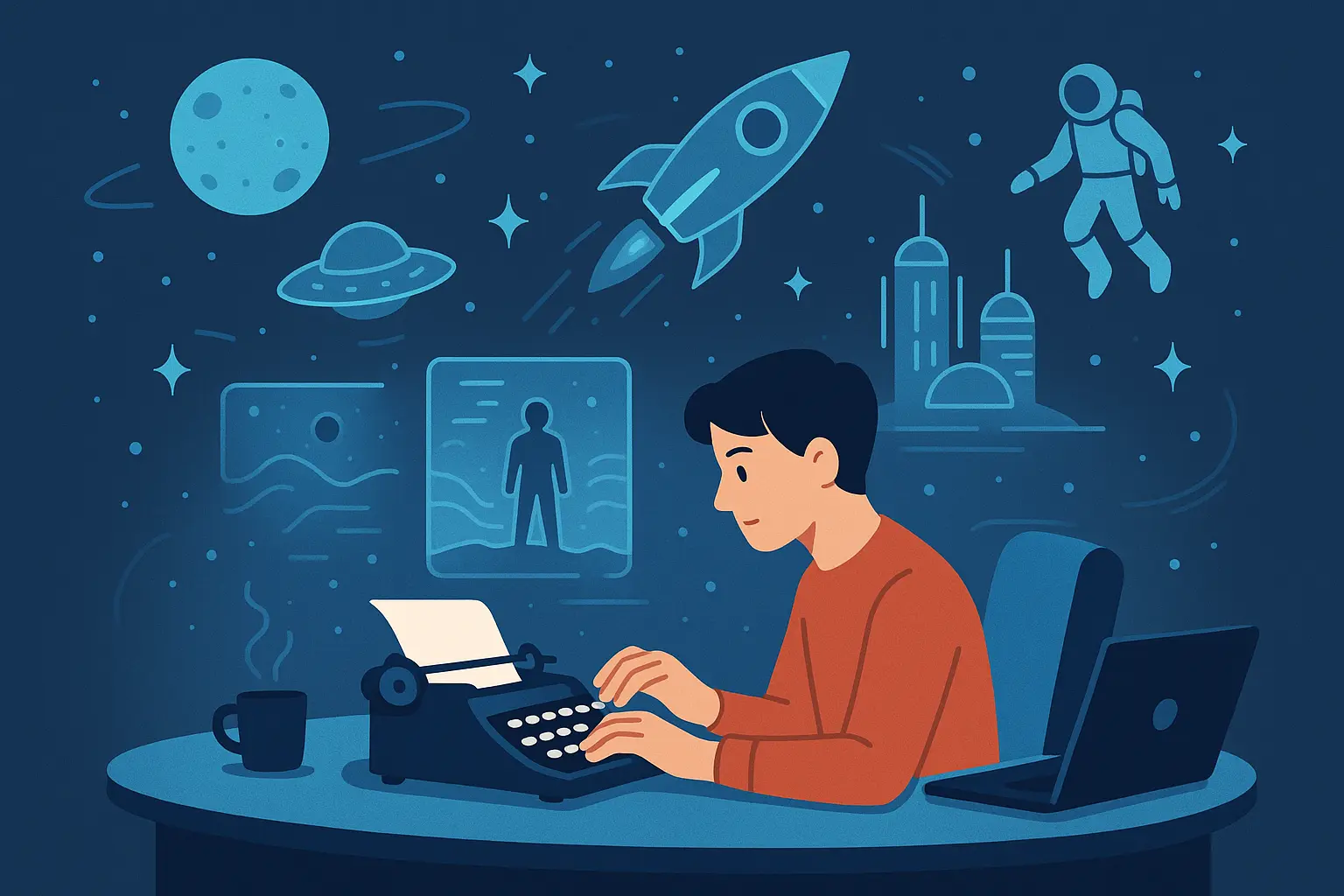
Final Thoughts
These 25 sci-fi stories represent the genre at its absolute finest—narratives that entertain while messing with your head in the best possible way. They show that great sci-fi doesn’t just predict tomorrow; it helps us understand today by showing us where our current choices and trends might lead us.
Each story succeeds because it grounds speculative elements in recognizable human experiences and emotions. Whether it’s exploring climate collapse through a botanist’s impossible choices or examining AI consciousness through therapeutic relationships, these narratives make the extraordinary feel both believable and emotionally devastating.
The diversity of themes and approaches in this collection reflects sci-fi’s unique power to examine contemporary issues from multiple angles. Climate change, artificial intelligence, biotechnology, space exploration, social media, and time travel all serve as vehicles for exploring deeper questions about identity, responsibility, progress, and what it means to be human when everything around us is changing at breakneck speed.
For readers seeking stories that’ll stick with you for weeks, this collection offers hours of engaging speculation about possible futures. For writers studying the craft, these stories provide masterclasses in narrative efficiency, character development, and thematic integration. Most importantly, they remind us that sci-fi’s greatest strength lies in helping us think more clearly about the present and the choices we make today that will shape tomorrow.
Trust me, these stories will mess with your head in the best way possible. You’ll never look at your smartphone, your smart home devices, or even your own reflection quite the same way again. And honestly? That’s exactly what great science fiction is supposed to do.



Add comment